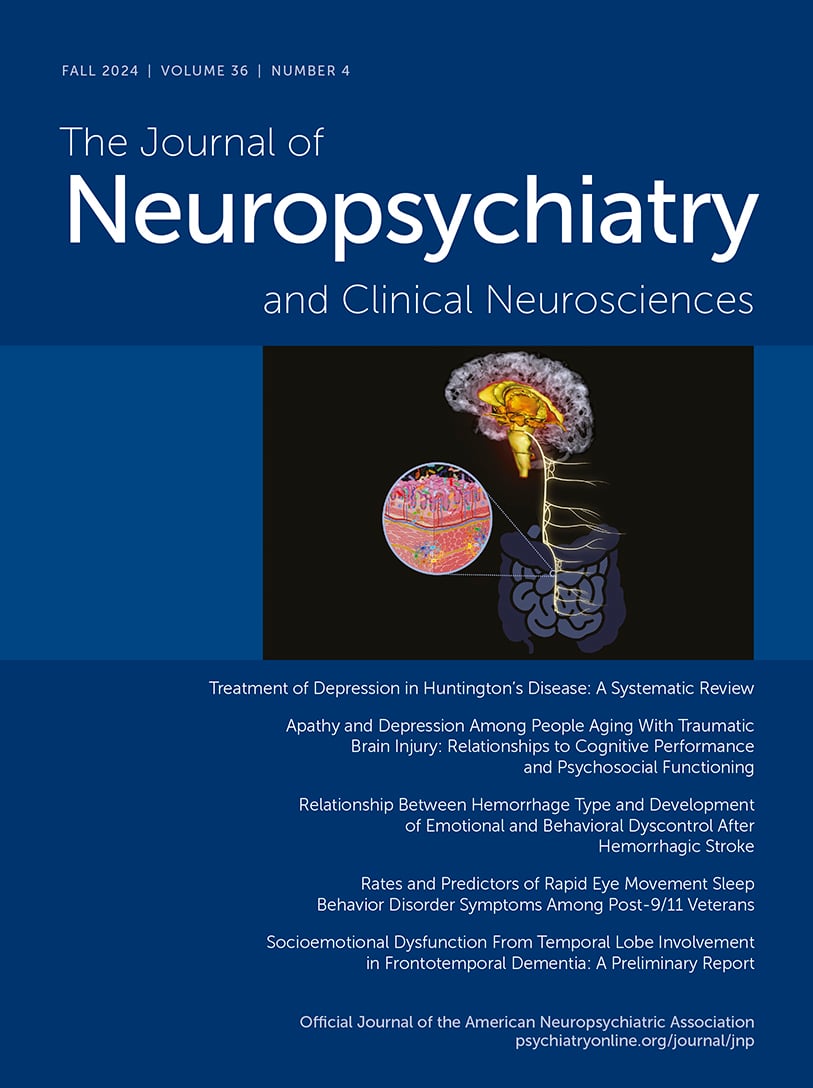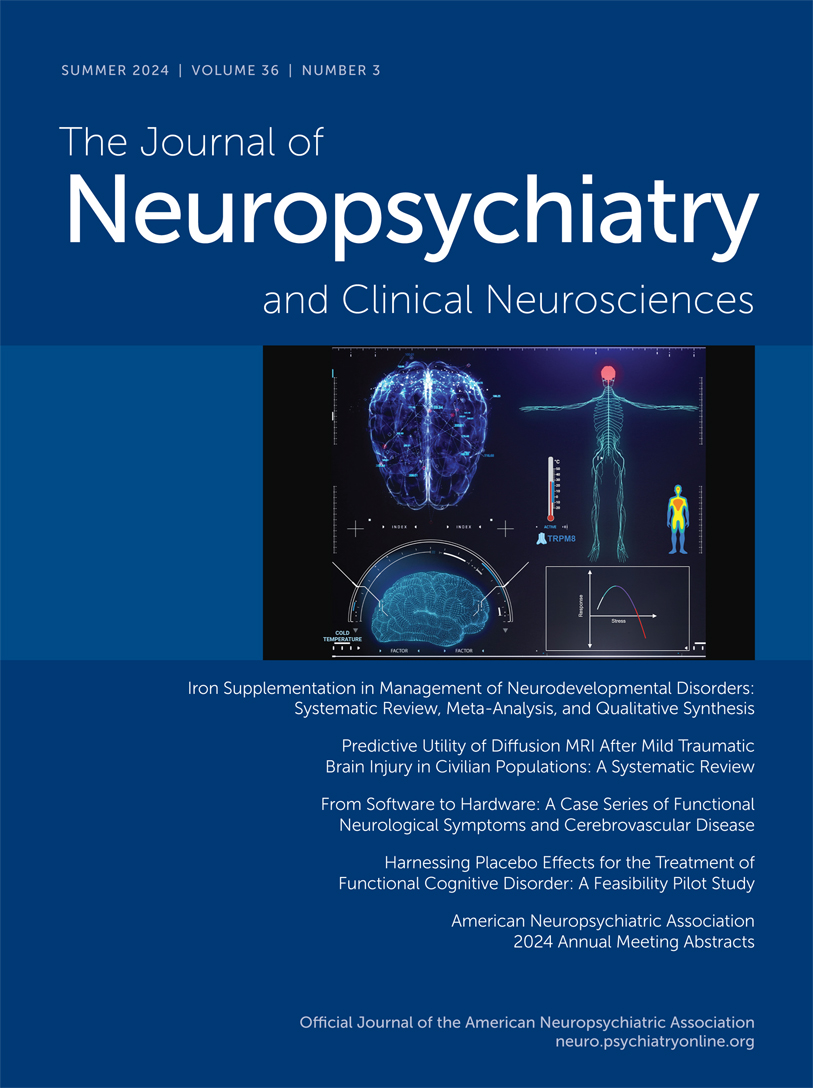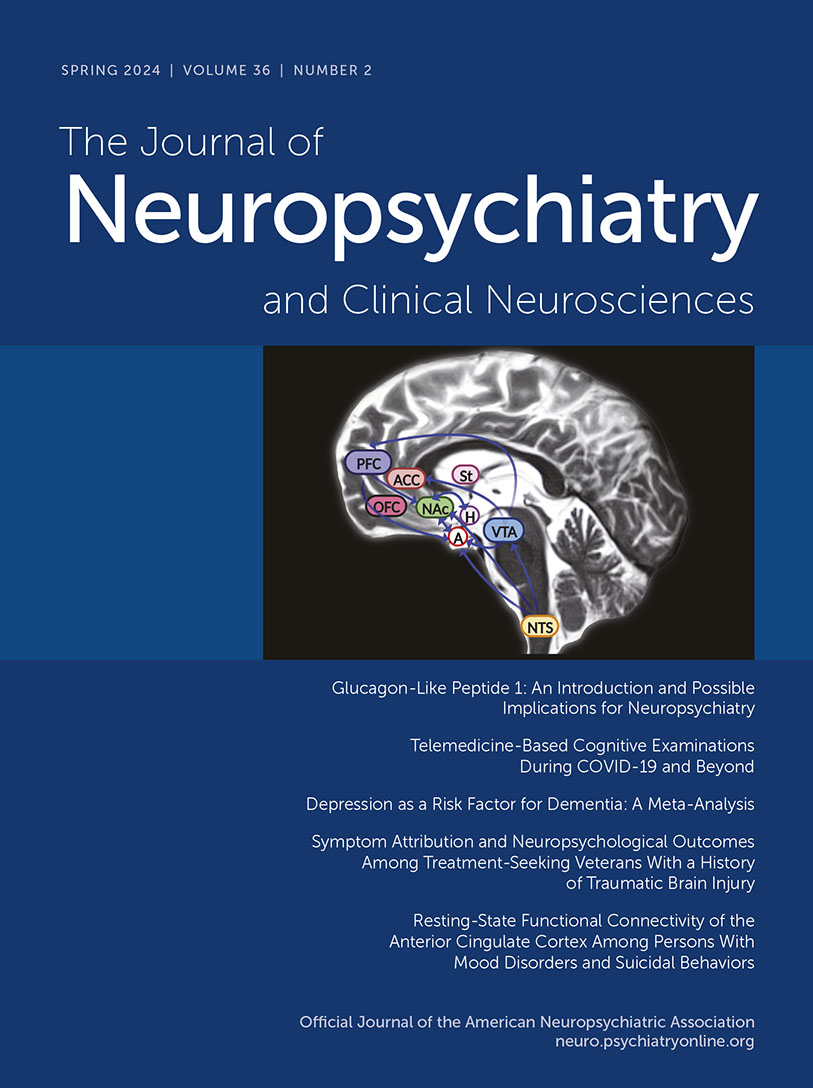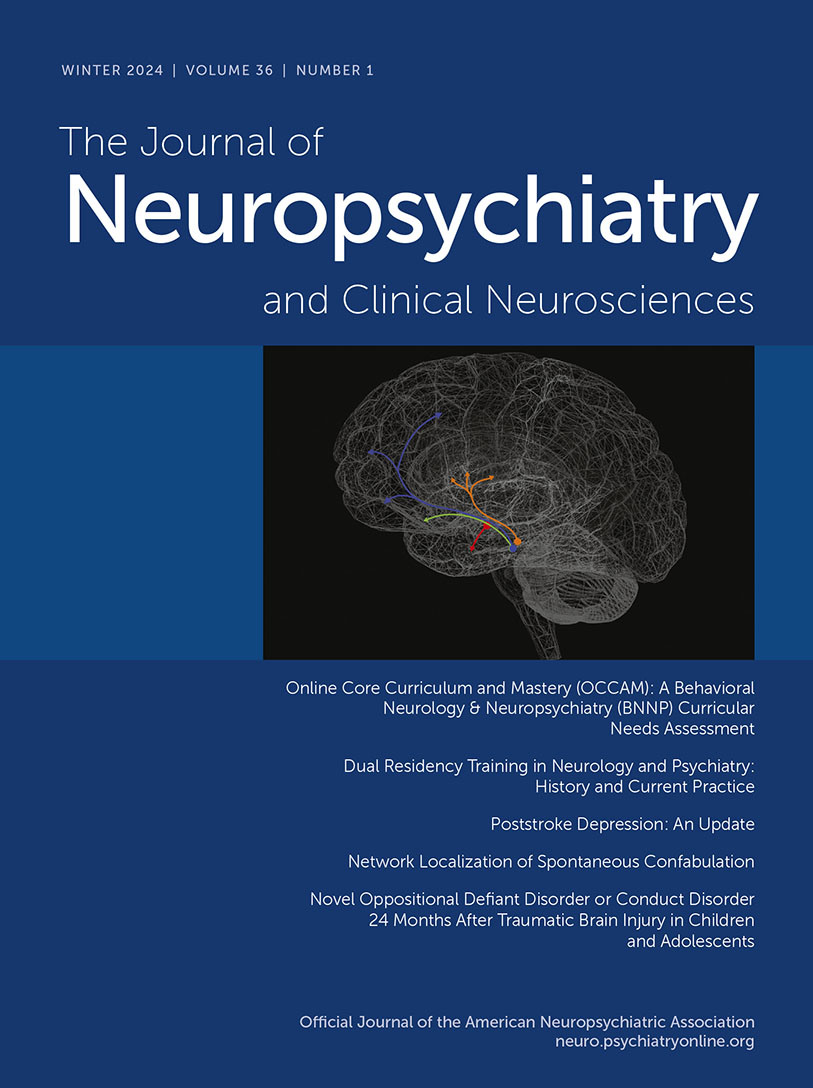The Journal of Neuropsychiatry and Clinical Neurosciences
- Volume 18
- Number 1
- February 2006
Windows to the Brain
Special Article
Publication date: 01 February 2006
Pages6–13Recognizing the fundamental congruence between behavioral neurology and neuropsychiatry, the Joint Committee on Subspecialty Certification of the American Neuropsychiatric Association (ANPA) and the Society for Behavioral and Cognitive Neurology (SBCN) ...
https://doi.org/10.1176/jnp.18.1.6Publication date: 01 February 2006
Pages14–20Hashimoto’s encephalopathy (HE) has been described as an encephalopathy, with acute or subacute onset, accompanied by seizures, tremor, myoclonus, ataxia, psychosis, and stroke-like episodes, with a relapsing/remitting or progressive course. HE patients ...
https://doi.org/10.1176/jnp.18.1.14Regular Article
Publication date: 01 February 2006
Pages21–32Phenomenology and predictive factors of personality change due to traumatic brain injury (TBI) 6 to 24 months after injury was investigated in children, ages 5 to 14 years, enrolled from consecutive admissions and followed prospectively for 2 years. ...
https://doi.org/10.1176/jnp.18.1.21Publication date: 01 February 2006
Pages33–38The effect of major depression on subjective and objective cognitive deficits 6 months following mild to moderate traumatic brain injury (TBI) was assessed in 63 subjects. Patients with subjective cognitive complaints (n=63) were more likely to be women, ...
https://doi.org/10.1176/jnp.18.1.33Publication date: 01 February 2006
Pages39–44Traumatic brain injury (TBI) frequently results in cerebrovascular lesions that may increase secondary damage and cause neuropsychological impairment. Previous studies suggest an association among the insertion/deletion (I/D) polymorphism of the ...
https://doi.org/10.1176/jnp.18.1.39Publication date: 01 February 2006
Pages45–53Twenty-six college women with a history of repeated childhood sexual abuse were recruited from the community and compared with 19 healthy female collegiate subjects on neurocognitive measures. Abused subjects showed increased response latency variability ...
https://doi.org/10.1176/jnp.18.1.45Publication date: 01 February 2006
Pages54–63The authors examined cognitive changes associated with treatment with ziprasidone and olanzapine over a 6-month double-blind clinical trial, using normative standards for the cognitive measures. Sixty-two schizophrenia patients entered the study on ...
https://doi.org/10.1176/jnp.18.1.54Publication date: 01 February 2006
Pages64–72Essential tremor (ET) is classified as a pure motor system disease. It has been previously reported that impairments in cognitive functions can be associated with ET. The authors assessed cognitive functions in a relatively young patient group with ET and ...
https://doi.org/10.1176/jnp.18.1.64Publication date: 01 February 2006
Pages73–80The embryological unity over early fetal life of the anterior brain, neuroepithelium, neural crest, and facial ectoderm is responsible for facial dysmorphogenesis in disorders of early brain development, including schizophrenia. This study examined ...
https://doi.org/10.1176/jnp.18.1.73Publication date: 01 February 2006
Pages81–85The authors aimed to explore schizophrenia patients’ ability to perceive affective prosody. Specifically, certain emotions that may be more troublesome for patients and possible gender differences in prosody perception were assessed. Thirty six ...
https://doi.org/10.1176/jnp.18.1.81Clinical and Research Reports
Publication date: 01 February 2006
Pages86–95Diminished legal responsibility and mental capacity have been used in defense of individuals with neurological disorders charged with legal misdemeanors, including criminal behavior. The purpose of this report is to 1) critically examine the mechanisms ...
https://doi.org/10.1176/jnp.18.1.86Publication date: 01 February 2006
Pages96–99The authors examined variations of serotonin transporter-linked promoter region (5-HTTLPR) functional polymorphism in 26 stroke patients with major depression and in 25 unrelated nondepressed stroke subjects of Caucasian descent. Findings indicate a ...
https://doi.org/10.1176/jnp.18.1.96Publication date: 01 February 2006
Pages100–107Frontotemporal dementia (FTD) is characterized by alterations in personality. The nature of the personality changes depend on the localization of the pathology. The authors present three patients with acquired extroversion who met criteria for FTD. All ...
https://doi.org/10.1176/jnp.18.1.100Publication date: 01 February 2006
Pages108–112The authors present a cross-sectional survey designed to evaluate the presence of delirium in patients with neurological emergencies. Two hundred and two patients were included in the study: 14.9% of subjects had delirium; 62.4% had no arousal ...
https://doi.org/10.1176/jnp.18.1.108Publication date: 01 February 2006
Pages113–116Parkinson’s disease with dementia (PD-D) and dementia with Lewy bodies (DLB) may result from the same neurodegenerative process with different temporal and spatial courses. The authors report an association between DLB and family history of dementia in a ...
https://doi.org/10.1176/jnp.18.1.113Publication date: 01 February 2006
Pages117–120The authors hypothesized that older depressed patients would perform more poorly on the Ascending Digits Task (ADT) when matched against a nondepressed elderly comparison group. In a novel measure, the ADT, 129 older depressives scored more poorly than ...
https://doi.org/10.1176/jnp.18.1.117Neuropsychiatric Practice and Opinion
Publication date: 01 February 2006
Pages121–128The authors assessed the number of referrals to neuropsychiatry services covering South London, Kent, Surrey, and Sussex (population 6,887,000) over a 2-year period. The average referral rate was 11.2 per 100,000 per population for each year. Geographical ...
https://doi.org/10.1176/jnp.18.1.121Letter
Calendar
Past Issues
View Issues Archive
Vol. 36 | No. 4

Vol. 36 | No. 3

Vol. 36 | No. 2
